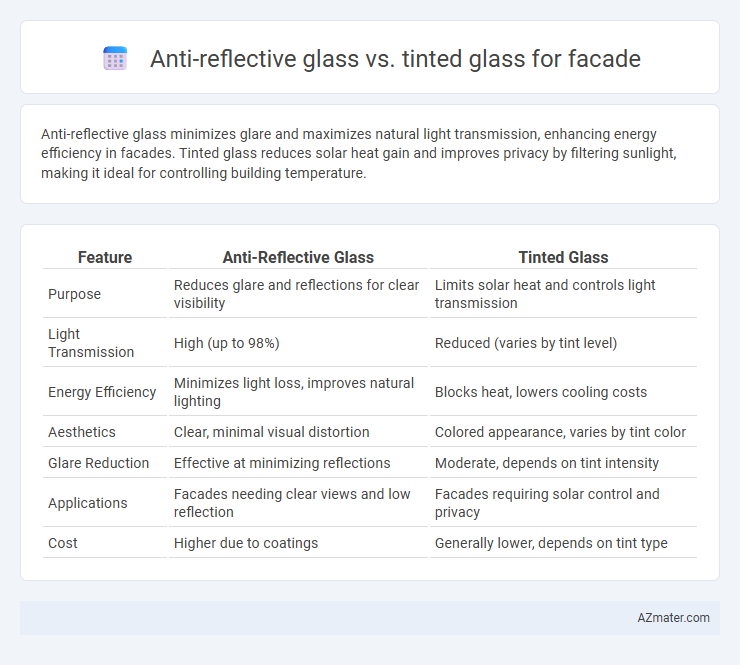Anti-reflective glass minimizes glare and maximizes natural light transmission, enhancing energy efficiency in facades. Tinted glass reduces solar heat gain and improves privacy by filtering sunlight, making it ideal for controlling building temperature.
Table of Comparison
| Feature | Anti-Reflective Glass | Tinted Glass |
|---|---|---|
| Purpose | Reduces glare and reflections for clear visibility | Limits solar heat and controls light transmission |
| Light Transmission | High (up to 98%) | Reduced (varies by tint level) |
| Energy Efficiency | Minimizes light loss, improves natural lighting | Blocks heat, lowers cooling costs |
| Aesthetics | Clear, minimal visual distortion | Colored appearance, varies by tint color |
| Glare Reduction | Effective at minimizing reflections | Moderate, depends on tint intensity |
| Applications | Facades needing clear views and low reflection | Facades requiring solar control and privacy |
| Cost | Higher due to coatings | Generally lower, depends on tint type |
Introduction to Anti-Reflective and Tinted Glass
Anti-reflective glass reduces glare and enhances visibility by minimizing light reflection, making it ideal for building facades where clarity and natural light penetration are priorities. Tinted glass incorporates color pigments to control solar heat gain and enhance privacy while reducing glare by absorbing and filtering sunlight. Both types of glass improve energy efficiency and occupant comfort but serve distinct functional purposes in facade design.
Key Differences Between Anti-Reflective and Tinted Glass
Anti-reflective glass minimizes glare and enhances visibility by reducing surface reflections, making it ideal for facades requiring clear views and natural light transmission. Tinted glass absorbs and blocks a portion of sunlight, providing thermal insulation and reducing solar heat gain, which helps improve energy efficiency and occupant comfort. The key difference lies in anti-reflective glass prioritizing optical clarity and reduced reflections, while tinted glass focuses on heat control and privacy.
Optical Performance and Light Transmission
Anti-reflective glass for facades significantly reduces surface reflections, enhancing optical clarity and maximizing visible light transmission, often achieving rates above 90%. Tinted glass, while reducing solar heat gain and glare, lowers light transmission typically between 20% to 70%, depending on the tint level, impacting natural illumination. The choice between anti-reflective and tinted glass hinges on balancing high transparency and glare control with thermal performance requirements for building facades.
Energy Efficiency and Solar Control
Anti-reflective glass enhances facade energy efficiency by maximizing natural light transmission while minimizing glare, reducing the need for artificial lighting and improving indoor comfort. Tinted glass provides superior solar control by absorbing and blocking a significant portion of solar heat, effectively lowering cooling loads and energy consumption in warm climates. Combining both technologies can optimize facade performance by balancing daylight utilization with heat reduction, leading to substantial energy savings.
Aesthetic Impact on Building Facades
Anti-reflective glass enhances building facades by minimizing glare and allowing true colors and architectural details to stand out, creating a sleek, modern appearance. Tinted glass contributes to aesthetic impact by adding color depth and contrast, often producing dramatic visual effects that change with light conditions. Both options influence the exterior design, but anti-reflective glass prioritizes clarity and natural light, while tinted glass emphasizes mood and shading.
Glare Reduction and Visual Comfort
Anti-reflective glass significantly minimizes glare by reducing surface reflections, enhancing visual comfort in building facades, especially in high-glare environments. Tinted glass lowers solar heat gain and softens daylight intensity, which also contributes to visual comfort but can alter natural light color and reduce brightness. Choosing between anti-reflective and tinted glass depends on specific glare reduction needs and desired daylight quality for optimal facade performance.
Durability and Maintenance Requirements
Anti-reflective glass features a durable coating that resists scratches and reduces glare, minimizing maintenance by preventing dirt accumulation and water spots. Tinted glass offers durability through its color-infused layers that resist fading and discoloration but may require regular cleaning to maintain visual clarity and performance. Both types withstand weather exposure well; however, anti-reflective glass generally demands less frequent upkeep due to its specialized surface treatments.
Cost Comparison: Anti-Reflective vs Tinted Glass
Anti-reflective glass typically costs 20-30% more than standard tinted glass due to advanced coatings that reduce glare and improve visibility. Tinted glass, while generally less expensive, offers energy savings by reducing solar heat gain but may require additional treatments to achieve similar optical clarity. Long-term maintenance and energy efficiency should be factored in when comparing the total cost of anti-reflective and tinted glass for building facades.
Environmental Considerations and Sustainability
Anti-reflective glass reduces glare and improves building energy efficiency by enhancing natural light penetration, leading to lower electricity usage for lighting and temperature control. Tinted glass mitigates solar heat gain, reducing cooling demands but may decrease natural daylight, potentially increasing reliance on artificial lighting. Choosing between these facade options impacts a building's overall energy consumption and carbon footprint, making sustainability assessments critical in design decisions.
Choosing the Right Glass Type for Your Facade
Anti-reflective glass enhances facade visibility by minimizing glare and maximizing natural light transmission, ideal for commercial buildings seeking clear views and energy efficiency. Tinted glass provides solar control by reducing heat gain and glare while offering privacy, making it suitable for facades in hot climates or urban environments. Selecting the right glass type depends on balancing daylight optimization, thermal performance, aesthetic preferences, and environmental conditions.

Infographic: Anti-reflective glass vs Tinted glass for Facade
 azmater.com
azmater.com